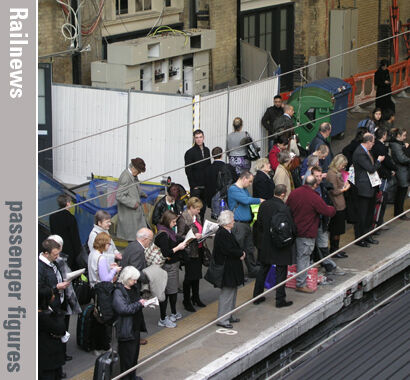New figures show that the demand for railway services is getting closer to levels recorded before the Covid pandemic, and could be about to overtake them.
The latest quarterly figures from the Office of Rail and Road for the three months to December 2024 show that passenger numbers grew by 7 per cent in the last quarter year-on-year, and that revenue was up by 8 per cent over the same period.
There were 446 million journeys, compared with 417 million journeys made in the same quarter in the previous year.
There were 1.7 billion journeys in the 12 months to December 2024, which was a 9 per cent increase on the 1.6 billion over the 12 months to December 2023.
Total passenger revenue in the latest quarter was £2.9 billion. This is an 8 per cent increase on the £2.7 billion in the previous year, when adjusted for inflation.
A total of 16.2 billion passenger kilometres were travelled in the latest quarter. This was a 7 per cent increase on the 15.1 billion kilometres in the previous year.
Meanwhile, the Department for Transport said passenger journeys in the week ending Sunday 2 March 2025 were 91 per cent of those observed in the equivalent week in 2019. In the current publishing period, weekly average usage figures have been between 81 and to 98 per cent of the same week before the pandemic, compared to 71 to 90 per cent in the last publishing period. These figures exclude the Elizabeth Line, where ‘updated adjustment factors’ are outstanding.
Railway Industry Association chief executive Darren Caplan said: ‘These figures by the ORR provide further, sustained evidence, of a return to rail post-pandemic.
‘Even in tough economic times, with a restructure in the offing, rail has a bright future. The Government clearly needs to continue to invest in it as the numbers using rail grow and more capacity will be needed.’
Readers’ comments
As ridership recovers to pre pandemic levels an important milestone is being reached. The challenge now is to reset business plans to capture the five missing years of growth lost from the implementation of the first lockdown and subsequent years of restrictions and disruption especially as individual market segments have recovered at different rates. As the Treasury has become increasingly impatient to see pandemic inflated revenue support removed increasing revenue yield is critical. However as industry reorganisation gathers pace towards the creation of GBR the opportunity already exists to ruthlessly address costs. It's no coincidence that the first operators to revert to direct control, SWR, Anglia & c2c, are closely aligned to the equivalent NR routes. Even in shadow form this should allow GBR to address the issue of track access charging and cost duplication immediately through a common accounts book.
Chris Jones-Bridger, Buckley, Flintshire
It does seem to me that competition can be a good stimulant to Inter City type operations. High speed IC services in both Italy and Spain are being run this way, with general positive results, whilst independent operators are making useful contributions elsewhere too. In some places in Europe, the open access operator is more aimed at travellers who want other criteria than speed and frequency (an example here could be "Flixtrain" in Germany whose emphasis is on Value for Money). Now emerging from the lock-down years, mainline services can be helped to reach an optimum by the "directing mind" putting incentivising subsidies and charges into the system, (rather than applying direct control – the railmen/women that head TOCs are likely to make a better hash of things than politicians and civil servants).
David C. Smith, Bletchley, Milton Keynes
Do you have a comment on this story? Please click here to send an email to Platform at Railnews.
Moderated comments will be published on this site, and may also be used in the next print edition.


